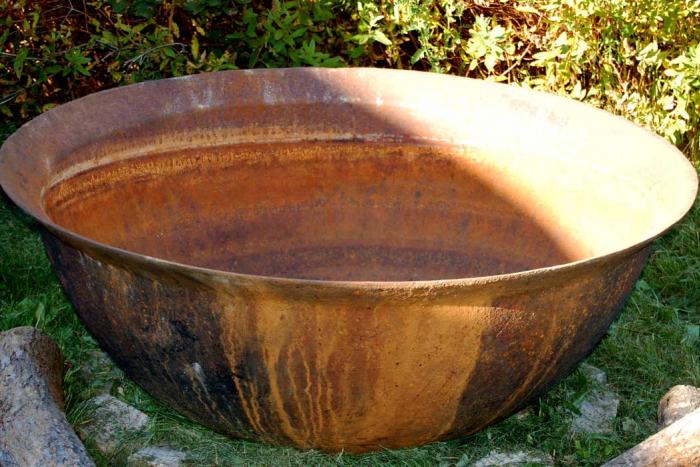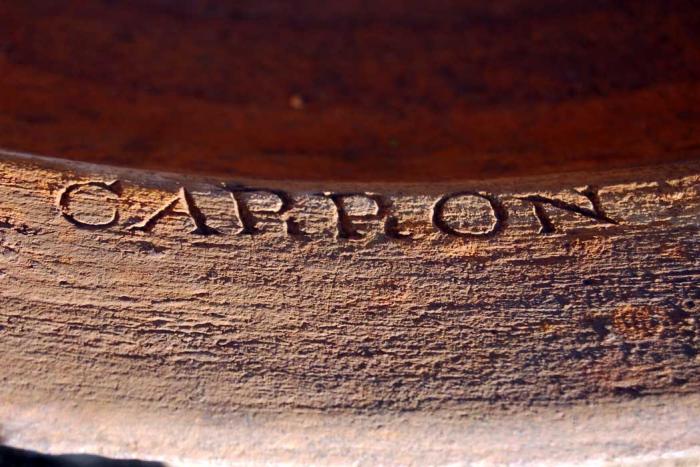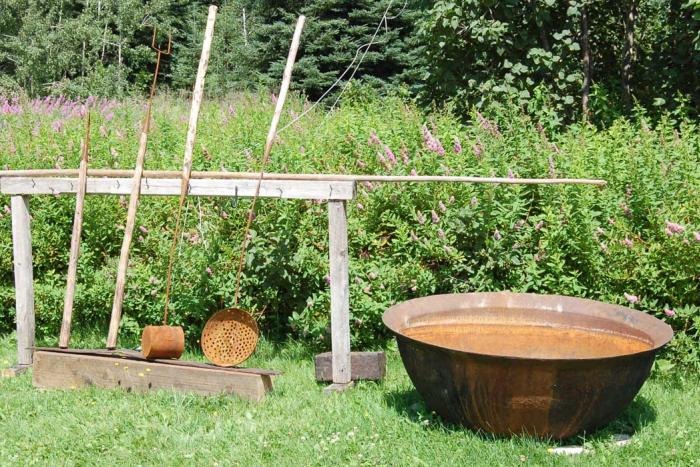Whaler’s Try Pot
Organization: Heritage Gaspé/Heritage Gaspésie
Coordinates: www.heritage-gaspe.org
Address: 580 Montée Wakeham Gaspé QC G4X 2A1
Region: Gaspé – Magdalen Islands
Contact: Jim Caputo, gaspecoast(a)sympatico.ca
Description: Cast iron whaling try pot originally owned by the Annett family of the Gaspé. Presently owned by Mr. Glenn Patterson, Wakeham, Gaspé.
Year made: 1800-1840
Made by: Carron Foundry – Falkirk, Scotland
Materials/Medium: Cast Iron
Colours: Black
Provenance: Scotland
Size: 1.35 m x 50 cm
Photos: Jim Caputo. Courtesy Heritage Gaspé/Heritage Gaspésie
Whaler's Try Pot
Jacqueline Hyman and Jim Caputo
High up in the crow’s nest, the lookout on a whaling ship keeps a keen watch on the water all around. Suddenly he spots a whale spouting, spraying moist air from its blow hole when it surfaces to breathe. ”There she blows!” he cries. With that call, 19th century Gaspé whalers are off on the hunt, a perilous adventure which was the life of many English-speaking Gaspé families of that era.
“Trying out” or boiling the whale blubber down to extract the oil was an important part of the process of turning whales into wealth. In the Gaspé, cast iron “try pots” -like the one pictured here - were waiting on land to receive the whale blubber to render it into precious and valuable lamp oil. Before being rendered, huge strips of whale blubber were cut into manageable pieces with an array of specialized tools such as double edged “boarding” knives. The surface area of the blubber was increased by slicing it into thin slices, about 2.5-centimetres (1 inch) thick, with double handled “mincing” knives. The thin slices were left attached to the black skin like the pages of a book attached to the spine. These were then called "books" or "Bible leaves."
Then the blubber would go into the pot. Heated from below it rendered blubber into a valuable oil which burned cleanly with little odour and was thus prized over animal or fish oil for the lamps of the day. Besides the whale’s blubber, other whale products were used, such as baleen (the plates that grow in the mouths of some whales for filtering krill and small fish that they eat). Baleen was used for buggy whips, parasol ribs or to stiffen women’s corsets.
In the 1800s, Gaspé whaling schooners searched for whales in the waters from Kamouraska to Anticosti Island, through the Straits of Belle Isle, north along the Labrador coast to the mouth of Hamilton Inlet, south and east throughout the Gulf of St. Lawrence and along the coast of Newfoundland. They may have gone further, but usually the whaling vessels built by Gaspé’s master boatwrights stayed in that area.
Among their captains and crew would have been men with the last name of Annett (the family that owned this try pot) or Boyle, or perhaps Coffin, Davis, Adams, Ascah, Baker, Miller, Harbour, Suddard, Tripp, Quigley or Patterson. These were some of Gaspé’s earliest whaling families. They knew each other, worked together, and intermarried. For example, John, George and Richard Annett were the owners of the whaling schooner built by the Boyle brothers in 1811 and named the Mary Boyle. There were many connections amongst these early English-speaking Gaspé families who were builders and owners, whalers and master mariners.
The first whalers in Canada were the Inuit, who hunted for subsistence. As early as the 16th century, French and Spanish whalers were profiting from the whales. In the 18th century, British and American ships cruised the Atlantic seaboard, and in the 19th century, Canadians entered the hunt, establishing whaling stations in Newfoundland, intensifying the hunt for the ever diminishing population of whales.
Many types of whales were hunted, but the Sperm and Right whales were especially prized for their oil. Gaspé whalers were part of a more localized deep-sea fishing industry during the 1800s. The whaling industry peaked for them in 1858, when six whaling schooners produced a total of 1,624 barrels of whale oil.
Legend has it that the first Gaspé whalers were taught their trade by whalers from Nantucket, a major centre of a huge whaling industry in the United States. It is said that two Nantucket cousins, named Coffin and Davis, were abandoned on the Gaspé shore by their unscrupulous captain because they would not lie to help him gain a government bounty on whale oil.
Bid farewell at a place known as Cape Gaspé, the two were left with nothing but the clothes on their backs, an axe, a muzzle loading gun and three days’ provisions. They survived, and eventually settled at what is still known as Cousins Cove (L’Anse aux cousins) and married into local Gaspé families. Stories about the beginnings of Gaspé whaling vary, depending on which whaling family you favour, but there is evidence that the first Coffin to settle in Gaspé was from Nantucket, where his family was involved in the whaling trade.
By the end of the 19th century, the Gaspé whaling industry was almost over. The discovery of petroleum made whale oil obsolete in spite of technological advances in weaponry that turned the whale hunt from a risky contest into an easy slaughter.
Whaling was a perilous venture. Once spotted, a whale was pursued by men in small boats launched from the mother ship. Positioning themselves within range, and at great risk, the men would harpoon the huge creature. Wounded, the whale would usually dive, or “sound,” running deep into the sea. This part of the chase was particularly dangerous for the men of the small boats as the tremendous force of the whale could either capsize the smaller boat, throwing the men into the sea, or smash the boat outright, with the same result. Once tired out from sounding and fastened to the boat, the whale could be killed with lances, towed to the larger ship and processed there or on land.
This try pot was made in the early to mid 1800s by the Carron Foundry in Falkirk, Scotland. The Carron Foundry was one of the largest iron works in Europe throughout the 19th century, supplying whaling try pots and naval cannons. The try pot is on view at the Heritage Gaspé/Gaspésie Heritage Pioneer Museum during the summer.
Sources
David J. Mcdougall, Ship Builders, Whalers and Master Mariners of Gaspé Bay in the 1800’s, Concordia University, Montreal.
McDougall, David J. McDougall, Two Centuries of Settlement of the Gaspé Coast by English-Speaking people http://www.gogaspe.com/douglastown/twocenturies.html
James F. Caputo, “The Whalers of Gaspé Bay - A Family Perspective,” with selected illustrations by Michelle Levesque. A Heritage Gaspé Booklet.
To Learn More
Ross Coffin, “ My Father’s Shoes-Our Coffin Story.” The Island Register.
http://www.islandregister.com/rcoffin/rcoffini.html
Benjamin Doane, Following the Sea, A Young Sailor’s Account of the Seafaring Life in the Mid-1800’s,1987.
David Lee, “Gaspé, 1760-1867,” Canadian Historic Sites, Occasional Papers in Archaeology and History # 23.
Thomas Lytle, Harpoons and Other Whalecraft. New Bedford: The Old Dartmouth Historical Society Whaling Museum, 1984.
Edith Mills, Remembrance, 1932.
New Bedford Whaling Museum, Moby Dick and the Tools of Whaling. New Bedford: 1983.
Raymond Patterson, Family Gatherings Vol. ll.
Kenneth Annett, The Annett Family of Gaspé, 1980.
Authors
Jacqueline Hyman is a writer and lives in the Eastern Townships. She is a member of the Board of Directors of the Eaton Corner Museum in Cookshire-Eaton, Quebec.
Jim Caputo is a retired school teacher and is president of Heritage Gaspé/Heritage Gaspésie.










Add new comment